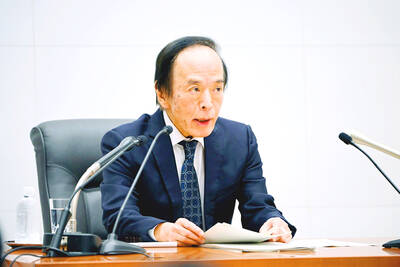Passive components maker Yageo Corp (國巨) yesterday reported that its second-quarter earnings surged to the highest level in about one-and-a-half years, thanks to rising demand for high-capacity passive components used in 5G smartphones, servers and computers.
Net profit jumped 40 percent to NT$3.3 billion (US$111.75 million) during the April-to-June period, compared with NT$2.35 billion in the first quarter and NT$1.42 billion a year earlier.
Earnings per share climbed to NT$7.01, from NT$5.51 a quarter earlier and NT$3.34 a year earlier.
Gross margin rose to 44.3 percent, compared with 40.3 percent in the first quarter and 32.6 percent in the second quarter of last year.
Yageo, the world's third-largest supplier of multilayer ceramic capacitors, said that it managed to boost its inventory to 60 days at the end of the second quarter to satisfy customer demand, compared with 30 days in the first quarter.
However, that is still well below a “healthy” inventory for the company, which is 100 to 110 days, it said.
For this quarter, the firm remains positive, despite the COVID-19 pandemic and US-China trade tensions, saying that revenue and profit would continue to trend upward due to the integration of newly acquired Kemet Corp and solid customer demand.
Kemet specializes in making passive components used in high-end 5G base stations, automobiles, industrial and aerospace applications, and medical devices.
The Kemet deal increased Yageo’s revenue 54.4 percent month-on-month to NT$7.01 billion last month.
The deal would help drive Yageo’s revenue higher this quarter by at least 50 percent from NT$10.02 billion last quarter, analysts said.
In the first six months of this year, Yageo accumulated NT$5.65 billion in net profit, surging more than 40 percent from NT$4.01 billion a year earlier, while revenue grew 12 percent from NT$20.97 billion to NT$23.49 billion.
Smaller rival Walsin Technology Corp (華新科技) on Monday posted net profit of NT$1.93 billion for last quarter, almost tripling the NT$693.93 million it made in the first quarter. On an annual basis, net profit grew 31.29 percent from NT$1.47 billion.
Earnings per share were the highest they had been in five quarters, at NT$3.98, compared with NT$1.35 a quarter earlier and NT$3.03 a year earlier.
Walsin said that it expects strong demand from laptops thanks to remote learning and telecommuting trends to extend into the second half of the year, while smartphone demand is rebounding after its first-half doldrums.
In the first two quarters, Walsin’s net profit fell more than 31 percent to NT$2.59 billion from NT$3.78 billion, and revenue dropped 6.25 percent to NT$15.16 billion from NT$16.17 billion a year earlier.

Taiwan’s long-term economic competitiveness will hinge not only on national champions like Taiwan Semiconductor Manufacturing Co. (TSMC, 台積電) but also on the widespread adoption of artificial intelligence (AI) and other emerging technologies, a US-based scholar has said. At a lecture in Taipei on Tuesday, Jeffrey Ding, assistant professor of political science at the George Washington University and author of "Technology and the Rise of Great Powers," argued that historical experience shows that general-purpose technologies (GPTs) — such as electricity, computers and now AI — shape long-term economic advantages through their diffusion across the broader economy. "What really matters is not who pioneers

In a high-security Shenzhen laboratory, Chinese scientists have built what Washington has spent years trying to prevent: a prototype of a machine capable of producing the cutting-edge semiconductor chips that power artificial intelligence (AI), smartphones and weapons central to Western military dominance, Reuters has learned. Completed early this year and undergoing testing, the prototype fills nearly an entire factory floor. It was built by a team of former engineers from Dutch semiconductor giant ASML who reverse-engineered the company’s extreme ultraviolet lithography (EUV) machines, according to two people with knowledge of the project. EUV machines sit at the heart of a technological Cold

TAIWAN VALUE CHAIN: Foxtron is to fully own Luxgen following the transaction and it plans to launch a new electric model, the Foxtron Bria, in Taiwan next year Yulon Motor Co (裕隆汽車) yesterday said that its board of directors approved the disposal of its electric vehicle (EV) unit, Luxgen Motor Co (納智捷汽車), to Foxtron Vehicle Technologies Co (鴻華先進) for NT$787.6 million (US$24.98 million). Foxtron, a half-half joint venture between Yulon affiliate Hua-Chuang Automobile Information Technical Center Co (華創車電) and Hon Hai Precision Industry Co (鴻海精密), expects to wrap up the deal in the first quarter of next year. Foxtron would fully own Luxgen following the transaction, including five car distributing companies, outlets and all employees. The deal is subject to the approval of the Fair Trade Commission, Foxtron said. “Foxtron will be

INFLATION CONSIDERATION: The BOJ governor said that it would ‘keep making appropriate decisions’ and would adjust depending on the economy and prices The Bank of Japan (BOJ) yesterday raised its benchmark interest rate to the highest in 30 years and said more increases are in the pipeline if conditions allow, in a sign of growing conviction that it can attain the stable inflation target it has pursued for more than a decade. Bank of Japan Governor Kazuo Ueda’s policy board increased the rate by 0.2 percentage points to 0.75 percent, in a unanimous decision, the bank said in a statement. The central bank cited the rising likelihood of its economic outlook being realized. The rate change was expected by all 50 economists surveyed by Bloomberg. The